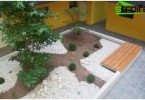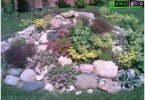There is an old joke where the British lord is asked about the secrets of growing perfect English lawns. To which he replies: “There are no difficulties – the grass must be constantly cut and watered. And do this for at least two hundred years. ” Perhaps the truth is hidden in a joke. To grow a lawn with grass of the best length and softness by yourself, it will take years of work and attention. But, now there is a way to quickly equip a place for relaxation in nature. It is only necessary to purchase a rolled lawn, laying and care of which everyone can afford.
Content
- What is a lawn coating
- The importance of preparatory work
- Tips for laying a lawn
- How to preserve the beauty of grass
What is a lawn coating
Biologists confirm that the natural creation of lawn grasses with a sufficiently high-quality and dense turf coating is not an easy task. It will take time and effort. Of course, the prospect of many years of work and expectation does not stop many. But today there is a simpler option – an artificial rolled lawn. Its purchase will not be cheap. But you can quickly create soddy areas on your site, decorate a garden, flower garden or yard. After only a couple of weeks after laying, the result will already be obtained – excellent grass.
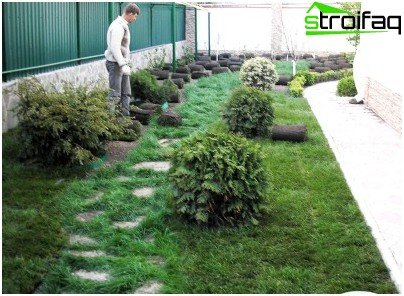
To get a magnificent lawn by the house, it is not necessary to look after it for years
In fact, the device of a rolled lawn differs little from grown independently. These are living herbs. Specialized farms grow them from seeds, which takes about 3 years. The finished material is a turf rug, the basis of which is a strong mesh base. One cut layer has a width of 0.4-0.6 m and a length of 1.9-2.15 m, depending on the manufacturer (i.e., the area is about 0.8-1.24 m. Sq.). The height of the material is approximately 2.5 cm. The turf can weigh from 15 to 30 kg. Such grass plates are simply rolled up. They are usually stored in stacks of pallets.
The importance of preparatory work
Having decided on a purchase, do not rush – the material does not tolerate long-term storage. Initially, thorough preparation of the soil for a rolled lawn should be carried out – without this, the lawn will not last long. The soil is treated according to the same rules as before sowing the usual suitable grass..
The site should be cleaned of stumps, household or construction waste that cannot be buried in the soil. Dissimilar grasses are removed from the ground along with turf. It is very important to carefully select the remaining weeds, especially rhizomes, from the prepared plot. This is plantain, coltsfoot, nettle, wheat grass, dandelions, chickweed, nettle, etc. It is recommended that in areas of special accumulation of such weeds to perform a herbicidal treatment such as “Roundup”. Before laying a rolled lawn, the soil should be dug up with a shovel or cultivator. Earth clods are crushed and crushed to a size of about 2 cm in diameter.
If on the site clay soils, poorly water-draining, a drainage cushion 5-10 cm high from a layer of sand and gravel is necessarily laid. This will prevent root decay and improve the water-air permeability of the soil surface. It is recommended to introduce various improving components into the soil (to enhance fertility, lower acidity, improve structure). A week before the time when it is planned to lay the roll lawn with your own hands, a complex fertilizer is applied to the site, about 50 g per square meter. All components mix well..
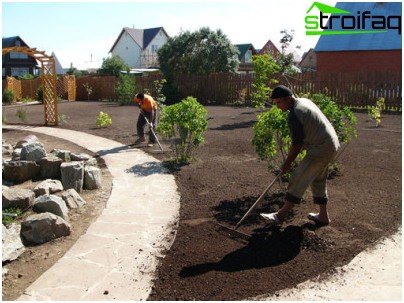
First you have to carefully prepare the soil
Then they proceed to the stage of planning the site, followed by rolling with a special skating rink (tamper). These works are carried out in dry weather, when the soil is not sticky. Rolling is necessary for leveling and compacting the soil, in which the fertile layer should exceed a thickness of 10-15 cm. The level of a flat, rolled soil should become 2 cm below the height of the tracks.
Tips for laying a lawn
Experts advise to get a rolled lawn in the spring, in the early autumn or in the summer. In the heat, regular watering is required. It is better to carry out work in dry but not hot weather..
It is advisable to immediately install the purchased grass cover without putting it into storage. It is recommended to lay the roll lawn with your own hands within a day or two after it has been cut and delivered to the customer. Before laying, rolled up rolls must be kept in a shaded place – in the sun and in the heat the grass can overheat, turn yellow and die. To prevent this, the plates are regularly watered. If for some reason the installation is delayed, the deployment and watering of the plates is allowed. This laborious work will extend the life of plants for another day or two.
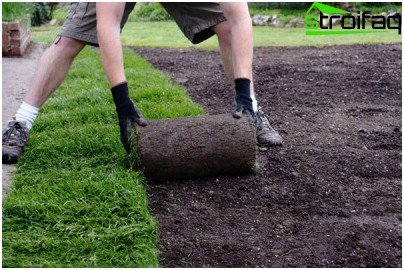
You can also independently install the purchased coating, following some rules
Starting to lay, the lawn mats neatly unfold, laying on the prepared sections of the soil in a strictly straight line. Work is carried out on a board or shield, so as not to push the sod. Having laid the first row, it is well rammed with a thick board to ensure full contact of the roots with the ground. Do the same with each subsequent flooring. In order not to tear the turf, you can not drive it in or push it hard. Rolling with a light roller to remove air and create a fit is allowed.
The row should end with the whole plate or its half. The next one begins to be laid with a half-roll of rolls to get a checkerboard pattern and not to combine transverse seams. Contacting grass strips should fit snugly together. The edges can be docked with a small slide so that after rolling there are no gaps. Do not overlap turf. Gaps between the plates are also not desirable, especially over 1.5-2 cm. On plots of land with a complex configuration, the plates are cut as necessary. But, you can not place small pieces of turf on the edges.
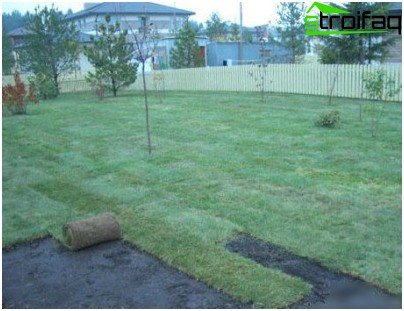
Rolls are laid in even adjacent rows.
Each received seam and ends of the lawn are covered with fertile soil composition. If the local clay soils – use a mixture of peat, loam and sand (in parts 1: 2: 4). For sandy soil, the proportions of the same components change (in parts 2: 4: 1). And on peat soil, a mixture of peat with sand (3: 1) is used. Immediately after laying, abundant watering is necessary so that the water not only dries the sod, but also the ground below it to a depth of about 3 cm.
How to preserve the beauty of grass
Walking along the recently covered sod area is not recommended for another 15 or 20 days, until the roots grow together with the soil. It is imperative to provide care for the rolled lawn so that the plates soon take root. In summer, in hot and dry times, you need plentiful daily watering. When the turf grows, it should be watered less often, 1-2 times in 10 days.

Grass longevity will only ensure proper care.
Starting from the second year, the grass will have to be mowed regularly (be sure to carefully remove the cut parts). An ideal height of greenery is 4-5 cm. The first mowing is carried out when the grass grows, and only its tips need to be cut. In subsequent times, the knives of the lawn mower are gradually lowered (they should always be sharp). Lawn mowing is available from mid-spring to October. In periods of rains, the grass mows more often and cuts lower. In dry season, it is not necessary to part, and the mower knives rise higher. From the moment of mowing, you can begin to feed the plants with mineral fertilizers. Do it better before watering.
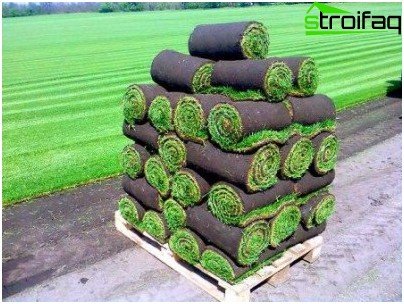
Grass plates can be easily rolled up
Before winter, you need to mow your meadow. When there is no snow and it’s cold, it’s better not to go around this area. And in the spring, by piercing the turf, get rid of puddles with melt water. When the soil dries, the grass will need to be combed and aeration.
You can quickly transform your land by creating a uniform coating on it with beautiful emerald grass. The first couple of years do not even have to worry about weed removal or pest control. Compliance with the simple rules for laying and caring for lawn rolls will allow to refine any landscape, including areas with steep slopes.


